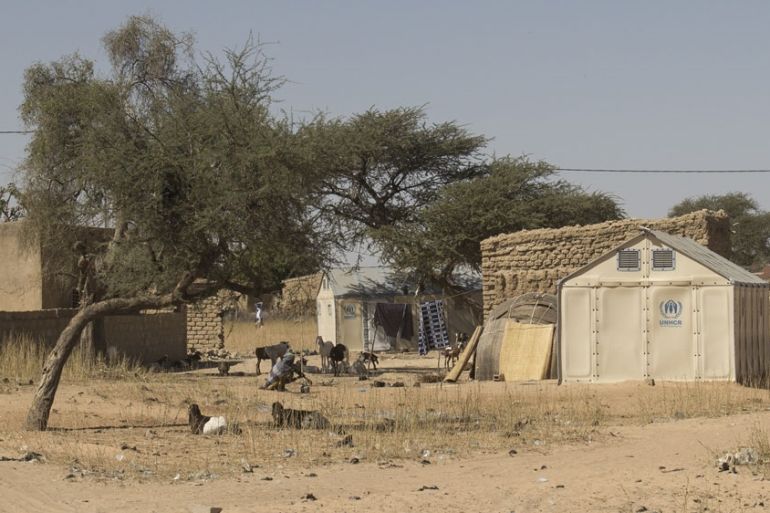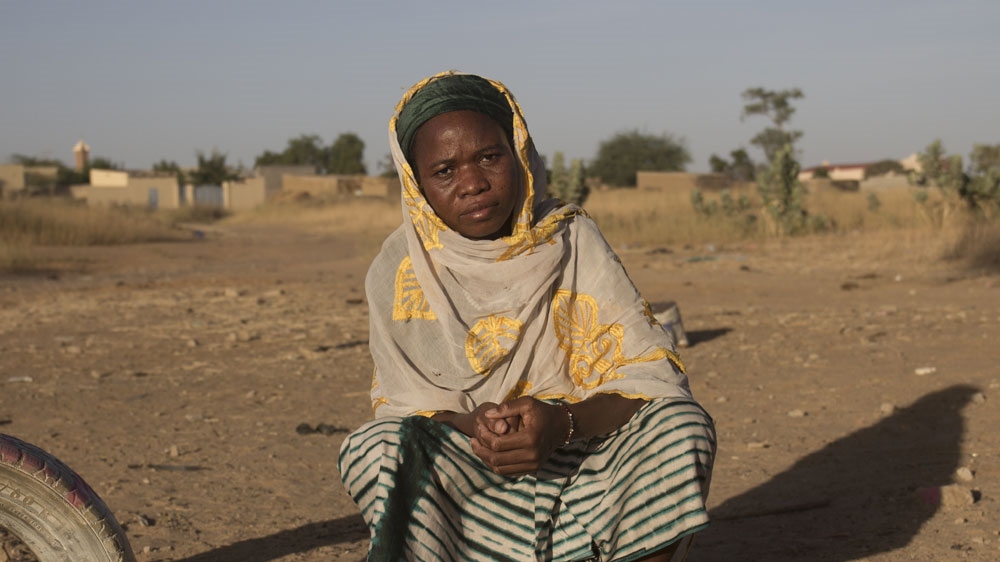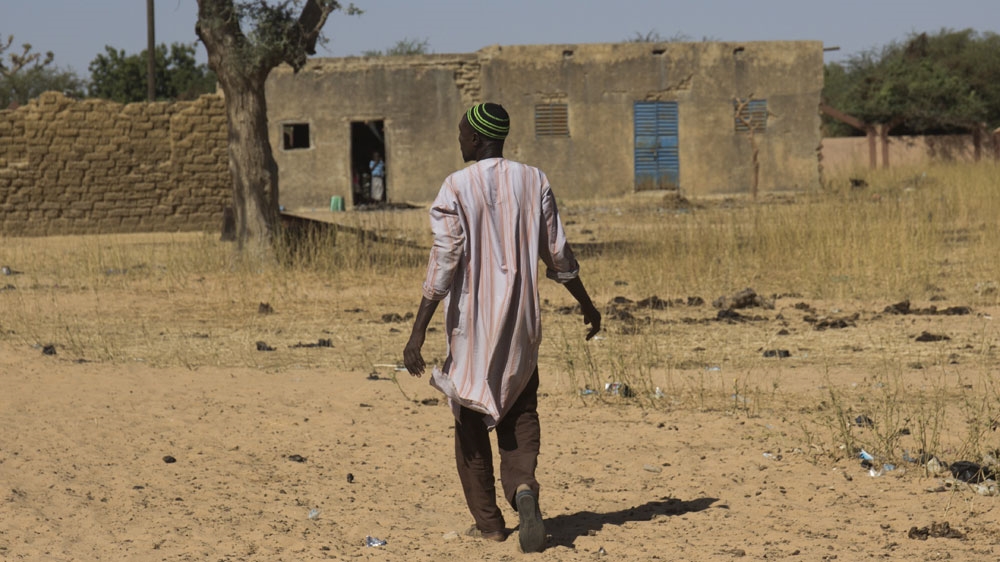Mystery behind Burkina Faso violence hampering response to crisis
Experts say the confluence of armed groups in the West African country is complicating humanitarian efforts.

Dori, Burkina Faso – Fati Niampa remembers hearing back in June about villages near her home town of Arbinda, in northern Burkina Faso, coming under attack.
“Men from Arbinda started to run away and hide in the bush,” says the 36-year-old, who at the time decided to stay behind in her family home.
Keep reading
list of 3 itemsFrance announces troop deployment to Burkina Faso
At least 14 killed in attack on Burkina Faso church
“When terrorists arrived in Arbinda, they started killing the men who didn’t flee. They killed my uncles and brothers. Males were the only targets: adults, teenagers, even babies. If they identified [a baby] as a boy, they would kill him.”
Niampa says she witnessed the death of at least one infant. Overall, 19 men were killed in the unclaimed attack on June 9.
“I saw about 15 terrorists. We couldn’t identify them. Their heads were covered with turbans. All we could see were their eyes and their mouths,” says Niampa, who fled to Dori, a relative haven from the fighting 100km (62 miles) away, where the United Nations’ children and refugee agencies provide support to internally displaced persons (IDPs).

Deadly attacks, such as the one on Arbinda, are a near daily occurrence in the north and east of Burkina Faso. The violence is causing people to flee their homes in numbers never seen before in a country which until a few years ago was considered relatively stable. Now, 486,000 IDPs, such as Niampa, are in urgent need of humanitarian assistance.
But, in much the same way as Niampa struggled to identify the attackers, authorities and humanitarian organisations in the West African country are often left to guess who is behind the violence, too.
According to The Armed Conflict Location & Event Data Project (ACLED), there have been 573 incidents in Burkina Faso’s conflict since the start of the year, with only a fraction claimed by armed groups – among them, Ansural Islam, Jama’at Nasr al-Islam wal Muslimin (JNIM) and Islamic State in the Greater Sahara (ISGS).
Nearly 2,000 people have died in Burkina Faso this year, according to data from ACLED. The number is more than six times larger than that of 2018 and now exceeds the number killed in neighbouring Mali, which had previously been the country worst-hit by violence in the Sahel region.
Paul Melly, a research fellow and Sahel expert at the think tank Chatham House, said besides the armed groups that have been active in Burkina Faso others also contribute to the instability in the country’s rural areas, including “traffickers and criminal gangs”.
“There have even been claims that former soldiers loyal to the [ex-President Blaise] Compaore regime, overthrown in the 2014 democratic revolution, may also be involved,” he said.

For many years, Burkina Faso’s dozens of ethnic groups have been well-integrated but more recently armed groups have been trying to force division between them in an attempt to stoke violence, analysts say. Tensions have been particularly high between the majority and politically dominant Mossi group and the six percent-minority Fulani group. Private feuds between individuals can also play a role in the worsening security situation.
The regions to the north and east of the capital, Ouagadougou, are mostly arid and inhospitable. The Sahel region, in the far north, where much of the fighting is taking place, is characterised by savanna and home to a majority of the Fulani ethnic group. Most people in this region are farmers, so the lack of security makes it extremely difficult to tend crops causing a nascent food crisis, according to the World Food Programme.
‘Who do we speak to?’
Melly points out that Ansarul Islam is the only group acting in Burkina Faso with a relatively clear ideological motivation, but they rarely claim attacks. The tangled mess of motivations behind the rest of the violence has created an atmosphere of confusion and, in turn, often deadlock for those trying to solve the crisis.
“In this situation, it is difficult for the government to develop a coherent political response or peace offer – or for humanitarian organisations to negotiate safe passage for aid,” he says.
Aid organisations operating in conflict zones frequently negotiate with armed groups, regardless of political alignment, to allow safe passage for aid convoys in areas they control.
In Somalia, aid deliveries are made to swaths of the country controlled by the al-Shabab armed group because aid agencies agree safe passage with them. According to a report by Crisis Group titled Speaking with the ‘Bad Guys’, aid agencies operating in Mali have succeded in engaging Katiba Macina, another armed group, who now allows humanitarians access to regions they control.

In spite of vast ideological differences with the aid agencies, many armed groups are willing to accept aid under the right circumstances.
In Burkina Faso, however, aid agencies are finding this nearly impossible. Since knowing which group controls areas of the country blighted by lawlessness is extremely difficult, the humanitarian organisations simply do not know who to negotiate safe passage with.
“There are several groups operating, so, to who do we speak?” asks Anne Vincent, the representative of the United Nations children’s agency (UNICEF) in Burkina Faso.
Gaining access for aid is the agency’s biggest constraint in Burkina Faso at the moment, she says.
“In Nigeria, you have Boko Haram; it’s one group. Maybe on some specific issues you can negotiate a humanitarian corridor. Here, it’s not the same. We have different groups and the relationship between them is not very clear. The modus operandi is different.”
“You cannot negotiate when you don’t know who is who?”
With the territories of different groups often overlapping, Vincent says there is a risk of negotiating with the wrong side.
“On top of that, we strongly believe that there are some links with international crime organisations or national crime organisations,” she adds.
Jared Thompson, a researcher with Sahel MeMo, says that “letting some attacks go unclaimed could very well be a strategic choice on the part of insurgent groups. [It] keeps the profile of insurgent groups lower, potentially avoiding the focused attention of the Burkinabe military and international security actors.”
He adds: “Burkina Faso is unique in this regard – as many as 80 to 90 percent of attacks go unclaimed, while the insurgency is expanding, and its human toll is surging at a dramatic rate.”